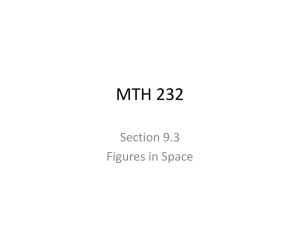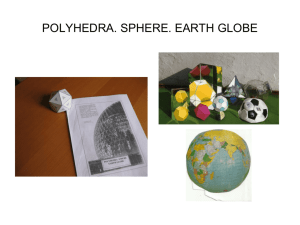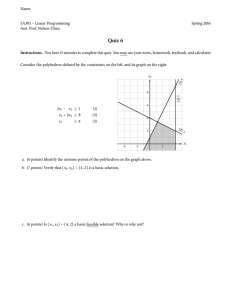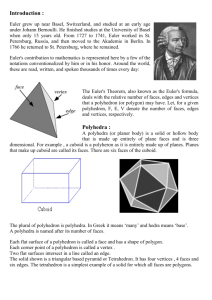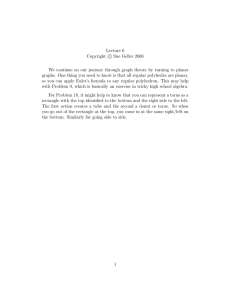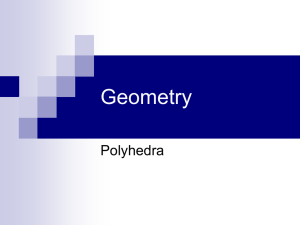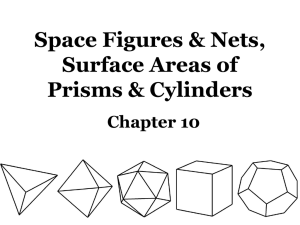From polyhedra to smoother shapes
advertisement
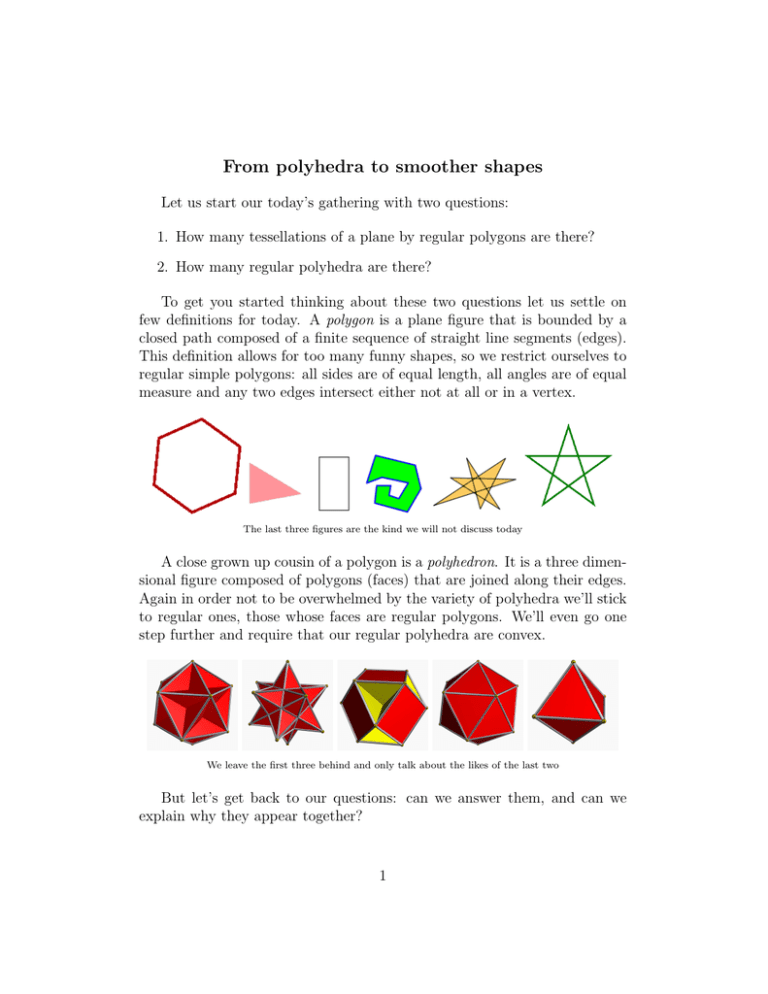
From polyhedra to smoother shapes Let us start our today’s gathering with two questions: 1. How many tessellations of a plane by regular polygons are there? 2. How many regular polyhedra are there? To get you started thinking about these two questions let us settle on few definitions for today. A polygon is a plane figure that is bounded by a closed path composed of a finite sequence of straight line segments (edges). This definition allows for too many funny shapes, so we restrict ourselves to regular simple polygons: all sides are of equal length, all angles are of equal measure and any two edges intersect either not at all or in a vertex. The last three figures are the kind we will not discuss today A close grown up cousin of a polygon is a polyhedron. It is a three dimensional figure composed of polygons (faces) that are joined along their edges. Again in order not to be overwhelmed by the variety of polyhedra we’ll stick to regular ones, those whose faces are regular polygons. We’ll even go one step further and require that our regular polyhedra are convex. We leave the first three behind and only talk about the likes of the last two But let’s get back to our questions: can we answer them, and can we explain why they appear together? 1 The answer to the first question becomes rather easy to obtain once we remember that our polygons have congruent angles and that they ought to fit snugly around each vertex. You could have thought about the second question in a similar manner: How can we glue regular polygons together so that they can form a polyhedron? But, we could approach the question from a different direction: Is there a way to fit a polyhedron in some space so that the knowledge of that space dictates the characteristics of a polyhedron? Or, could the question of number of regular polyhedra be connected to a question of tiling something other than a plane? Let’s go back to polyhedra and try to see how important their shape is. In other words, is there something that is common to all polyhedra? Every once in a while, when faced when a problem that is new, it could be useful to go back to the basics, and it doesn’t get more basic than counting. So, pick your favorite solid (doesn’t have to be regular) and count what you can. Then change your solid around, give it a few kicks, stretches, pushes and pulls, but gently. For example, I like cubes. I counted its faces, edges and vertices and got: F = 6, E = 12, V = 8 My cube is looking slightly sickly, I should probably help it a bit. I propped it up, just like you would a tent, and got this: I counted again, and this time my count changed. What happens with your favorite polyhedron? Do you notice anything? Can you explain it? 2 Let us consider any polyhedron. Remove one of its faces like this: If the surface of the polyhedron was made of some nice pliable stretchy material, then by pulling the edges of the missing face away from each other, we can deform all the rest and lay it nicely into the plane. We got a network of points and curves. Regular faces cease to be regular polygons if of course they were regular to start with. However, the number of vertices, edges and faces remained the same as those of the given polyhedron (the removed face corresponds to the exterior of the network.) We are going to apply repeatedly a series of additional transformations that would simplify the network without changing F − E + V : 1. If there is a polygonal face with more than three sides, we draw a diagonal. This adds one edge and one face. Continue adding edges until all the faces are triangular. 2. Remove (one at a time) all the triangles with two edges shared by the exterior of the network. This removes a vertex, two edges and one face. 3. Remove a triangle with only one edge adjacent to the exterior. This decreases the number of edges and faces by one each and does not change the number of vertices. Carry out steps 2 and 3 repeatedly one after another until only one triangle is left. For a single triangle F = 2 (counting the face we removed), E = 3, V = 3. Therefore F − E + V = 2, which proves Euler’s Formula: For a simple polyhedron F − E + V = 2. It did not matter which polyhedron we started with. What mattered, as far as we are concerned, is that all the polyhedra are essentially spheres. Remember that their surfaces are made of balloon like material. If we inflate the balloon, what we get is a sphere. All the edges and vertices were smoothed out, but we can still see their marks (say we had a foresight to color them purple). Or, to put it slightly differently, we would have a tessellation of a 3 sphere by polygons. This tells us that regardless of which subdivision of a sphere into polygons we consider, we will always get V − E + F = 2. You might have already known, or guessed by now, that the number V − E + F is rather special so that it even got a name: Euler number (characteristic). This number is a topological invariant: any two spaces that can be homeomorphically 1 mapped into each other will have equal Euler characteristic. Now we can go back to our polyhedron problem: Problem In how many different ways can you tessellate a sphere by regular polygons? Is there really anything special about the sphere? Can’t we look for decompositions and Euler characteristics of other surfaces? Let’s branch out. Problem Find the Euler characteristic of • a torus: • genus 2 surface: • genus 3 surface: Problem Find the Euler characteristic of genus g surface. 1 Two spaces are homeomorphic if there is a continuous bijection between them. 4
